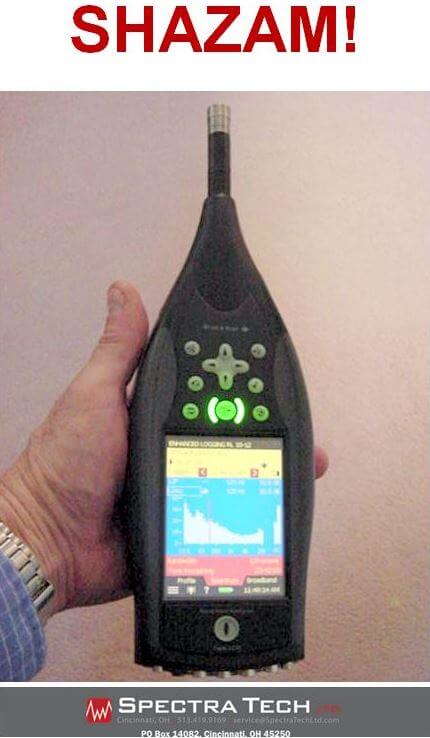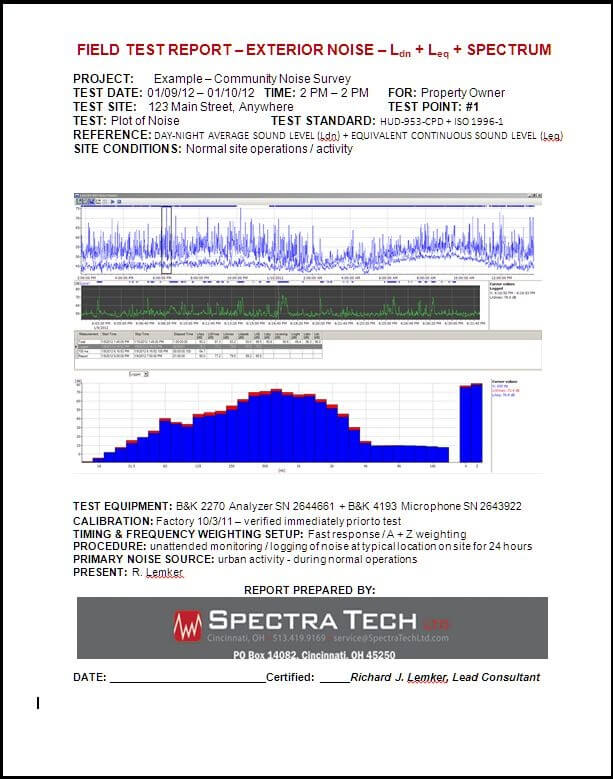Spectra Tech employes sophisticated equipment to measure and document many types of sound pressure levels (SPL) at interior and exterior test sites. Some characteristics of sound levels that we can document include the following:
- Decibel (dB): The measurement unit for expressing the relative intensity of sound. A direct application of linear scales (in Pa) to the measurement of sound pressure leads to large and unwieldy numbers. As the ear responds logarithmically rather than linearly to stimuli, it is more practical to express acoustic parameters as a logarithmic ratio of the measured value to a reference value. This logarithmic ratio is called a decibel or dB. The advantage of using dB can be clearly seen in the below illustration. Here, the linear scale with its large numbers is converted into a manageable scale from 0 dB at the threshold of hearing (20 microPa) to 130 dB at the threshold of pain (100 Pa). Our hearing covers a surprisingly wide range of sound pressures – a ratio of over a million to one. The dB scale makes the numbers manageable
- Frequency weighting: Our hearing is less sensitive at very low and very high frequencies. In order to account for this, weighting filters can be applied when measuring sound. The most commonly used weighting is the ‘A-weighting’, which approximates the human ear’s response to low – medium noise levels. A ‘C-weighting’ curve is also used, particularly when evaluating very loud or low-frequency sounds.
Spectra Tech Ltd, acoustic, noise, vibration, test instrument, data logging computer system, Field Sound Transmission Class, onsite, on-site, field, test - A-weighting filter: Frequency weighting corresponding approximately to the 40 dB equal loudness curve, that is to say, the human ear’s response at low to medium sound levels. It is by far the most commonly applied frequency weighting and is used for all levels of sound.
- B-weighting filter: Frequency weighting corresponding approximately to the 70 dB equal loudness curve, that is to say, the human ear’s response at medium sound levels.
- C-weighting filter: Frequency weighting corresponding to the 100 dB equal loudness curve, that is to say, the human ear’s response at fairly high sound levels. Mainly used when assessing peak values of high sound pressure levels.
- Z-weighting: ‘Zero’ frequency weighting is without any frequency weighting, that is, equivalent to Linear, LIN or FLAT.
- ‘F’, ‘S’ or ‘I’ time weighting: A time weighting (sometimes called a ‘time constant’) defines how the exponential averaging in root-mean-square (RMS) measurement is done. It defines how the heavily fluctuating sound pressure variations are smoothed or averaged to allow useful readings. The standards define three time weightings: F (Fast), S (Slow) and I (Impulse). Most measurements are carried out using the ‘F’ time weighting, which uses a 125ms time constant.
- Frequency: The number of pressure variations per second. Frequency is measured in Hertz (Hz). The normal hearing for a healthy young person ranges from approximately 20 Hz to 20000 Hz (20 kHz).
- 1 Octave Filtering: The ability to simultaneously measure the sound level for each octave frequency band between 20 Hz and 20,000 Hz (20KHz).
- 1/3 Octave Filtering: The ability to simultaneously measure the sound level for each 1/3 octave frequency band between 20 Hz and 20,000 Hz (20KHz).
- Recording / Logging: The ability to record or periodically log the sound level over a predetermined test period, from one second to one day in duration.
- Plot / Print Test Results: We can provide documentation of test results by plotting / printing the test values on paper, and / or provide the results in PDF format.


LINKS TO RELATED REFERENCE INFORMATION
- Noise, Scale, Common, Sources, Spectra Tech Ltd, Consultant
- Noise Levels of Common Exterior Sources, Spectra Tech Ltd, Consultant
- Sound Dispersion, vs, Distance Chart, Spectra Tech Ltd, Consultant
- Guidelines, A-weighted Sound, System, Levels, Spectra Tech Ltd, Consultant
- Wavelengths of Energy, Frequencies, in Feet and Meters, Spectra Tech Ltd, Consultant
- Frequency Ranges of Various Voices and Musical Instruments [link at Independent
- Audio for the Elderly
- Understanding, Science of Audio, Acoustics, – 12 page publication – PDF format, Spectra Tech Ltd, Consultant
- Sound Dispersion, vs, Distance Chart, Spectra Tech Ltd, Consultant
- Guidelines, A-weighted Sound, System, Levels, Spectra Tech Ltd, Consultant

